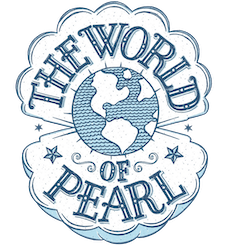If you have white pearls, there are a strong possibility they were bleached. Bleaching pearls is an extremely common treatment done to white pearls. Almost all akoya pearls from Japan and freshwater cultured pearls from China are bleached.
Why? Well, bleaching is a great way to clean and brighten the pearl surface and it lends a more uniform look to pearls. This becomes important when matching pearls in a strand or bracelet.
There are two processes for bleaching depending upon the type of pearl. Japanese saltwater akoya pearls are drilled and then placed in vessels of hydrogen peroxide. These vessels are then placed under strong fluorescent lights where they can be kept there for as little as two weeks or as long as six months. Obviously, the higher quality akoya pearls need less of this treatment. All goes well unless the technician leaves the pearls in the solution for too long. Long-term peroxide bleaching techniques can eat away the surface of the pearls and make them look chalky.
In China, technicians are secretive about their methods. Although they use hydrogen peroxide as well, they first put the freshwater cultured pearls in a jar filled with a heated cleaning solution. This solution is meant to clean the pearls. Afterwards, this cleaning solution is drained and refilled with a bleaching solution. Freshwater pearls are bleached for up to two weeks.
So, is this bleaching a good thing or a bad thing? There are debates and valid arguments on both sides but, no matter what, this is the only thing. This practice has been in place for almost a hundred years, not too many people talk about it and it is not changing. Bleaching pearls is here to stay. In fact, many companies bleach their pearls even if they go on to dye them later.
I am a modern day treasure hunter who travels the world for gorgeous pearls and amazing adventures. I own a pearl jewelry and jewelry repair business, ThePearlGirls.com, with a cute retail store in Athens, GA. I also have a Pearl Travel business and travel blog at TheWorldofPearl.com.






I was wondering the same thing with chocolate pearls. Do they exist like that in nature or are they all dyed? Thanks!
Hi Christy! Great question! A majority of chocolate pearls on the market are dyed. When you see major retailers featuring chocolate pearls, especially if they are a more affordable price, these are most likely dyed.
There are some naturally occurring chocolate pearls that come from saltwater pearl productions. I picked up some beautiful chocolate pearls from our trip to the pearl farm in French Polynesia. Although the typical Tahitian Black Pearl is definitely not chocolate, these mollusks can produce pearls that have more of a chocolate tone. The same is true of Fiji pearls. I saw some out of this world beautiful chocolate pearls in Fiji. They were closer to maroon in tone and they were way beyond the capacity of my pocketbook. But they were so pretty to look at!
Best,
India
Hi-
My pearl necklace was left in a purse with a blue ink pen that leaked. What’s your recommendation for the best way to clean it?
Oh Sam, you have got me there. I am so sorry! I bet those sweet pearls just soaked that ink right up.Does a mild soap or water help? The only other thing I can think of is sunlight. Colored pearls will fade in sunlight over time so maybe the sun would fade the ink out of your pearls? Sorry I wish I could be of more help! Good luck and let me know if you land on anything that works!
is it common for pearls to crack if they’ve been bleached?
Hi Claire! Typically bleaching in and of itself would not cause a pearl to crack. Robbing pearls of moisture by storing them in a vault or safe might make them crack from excessive dryness. Also, a poor nucleus might make a pearl crack, especially while drilling. Thanks so much for reaching out! Best, India